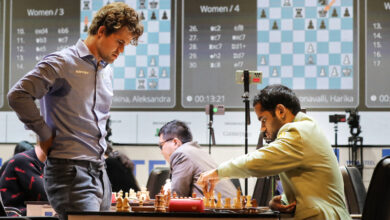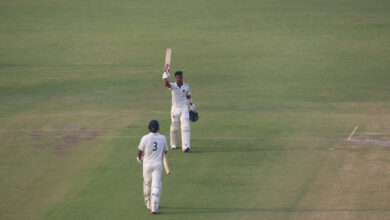Masters of art: How the twain of VS Naipaul and Sonny Ramadhin met

A week after his teenage son Vidiadhar left for England to pursue his ambition to become a writer in 1950, Seepersad Naipaul went to the house of another teenager who had left the village in Trinidad the same year and was wreaking havoc in England. The senior Naipaul, who would later write aching letters to his son who would be gripped self doubts about his writing ambitions and slipping into depression, would tell about the visit. An impressed Vidia would urge his father to send the piece to the London papers as Ramadhin was “known to everyone in England, and very few knew anything about his background”.
Ramadhin was 19 then and erasing post-colonial sores of the Caribbean people, along with the 20-year-old bespectacled spinner Alf(red) Valentine, charging West Indies to their first great triumph at Lord’s over the English. Together they took 59 wickets in the series, Ramadhin winked out 11 for 152 at the Lord’s, and West Indies would win a horic series 3-1. Cricket was never just a game from then on in the Caribbean which relished the comeuppance over their colonial masters. Especially as several of them had only recently gone on the ship Windrush to work in England, and would melancholically come to be known as the Windrush generation.
“When Ramadhin’s arm came over to bowl, they couldn’t tell whether the ball would turn left or right, go straight, or keep low, lift, or disappear into thin air,” his friend, the judge Ralph Narine, would beautifully capture the mystic effect years later. It was Narine who welcomed the shy teenager at the Waterloo station shivering in a “brownish overcoat” in the cold April wind. It’s the English who felt his cold jabs across the open cricket fields.
From back of beyond
Back home, Naipaul Sr would take two photographs of the house in which Ramadhin grew up and type out a story for The Sunday Guardian, the newspaper he worked in. He would capture vignettes that moved his son: A loving grandmother who fretted about Ramadhin’s shyness and her desire for him to get married soon.. The orphan boy who grew up in grandmother and aunt Sumintra and uncle’s care. The unlikely setting of the village where, in Naipaul Sr’s words, there was a greater chance of finding a cricketer in “Timbuktu than Esperance in Trinidad”.
In the years to come, when he was in India to play cricket, Ramadhin would talk about how his grandfather had hailed from Uttar Pradesh. He was a descendant of indentured labourers, plucked out of India the English, who worked in East Trinidad in sugarcane plantations and agricultural estates. Couple of decades ago, the professor of hory David Trabolay, who also hailed from the neighbourhood before he moved to the US, caught up with the aunt who spoke about how Ramadhin would play with bats carved off coconut trees and ball fashioned off rubber squeezed from rubber trees.
In his academic paper for College of Staten Island, written with an obvious love for its subject, Trabolay narrates a story told the aunt. “Once, when Ramadhin replied to his uncle’s request to help him work the garden that he was going to play cricket, his uncle quipped: ‘How are you going to make a living with cricket?’ To this Ram replied: ‘You’ll 11 see, daddy, I will make a living with it’.” Not just his uncle but the entire cricketing world would watch.
English chapter
England was the country where he would soon settle down, play in Lancashire leagues till 55, marry a local girl, and run a pub for twenty years and it all started like a dream in 1950. The literary critic James Wood once described VS Naipaul as a “writer with conservative vision but radical eyesight”; Ramadhin’s bowling was all radical.
Full sleeves buttoned at the wr, a cap permanently perched on his head – rumours swirled around that he would touch it as a signal for his leg break to the wicketkeeper but was later squashed him as a mere natural tick, he was the one of the early mystery spinners the world had seen. Not many knew what he bowled then; even in Trinidad for he and Valentine were plucked out of near anonymity for their potential to bewilder the English. In the late 90’s, in an interview with The Daily Mail, he would admit that he chucked some of his deliveries—his full-sleeves, no wonder, became the official dress code for mystery spinners with a slight kink in their arms.
At Lord’s he bamboozled the English, taking 11 wickets, and walking into at least three calypsos and a gorgeous poem. The most famous calypso was crooned Lord Kitchener who sang about the game “…. At Lord’s where I saw it, Yardley tried his best, Goddard won the Test … With those little pals of mine, Ramadhin and Valentine.” A lesser known one, Norman Span aka ‘King Radio’, joyously ran: ‘Give the ball to Ramadhin’. Later, the Trinidadian poet Cecil Gray raved in a poem titled ‘Sonny Ramadhin’: “the ball is ‘an orb investing us with power’ …. The name of Ramadhin made pride plush our veins”.
The veins probably constricted a bit on Ramadhin’s next series, the tour of Australia. He picked up a five-for at Brisbane, but wasn’t as effective on the hard-boiled tracks where the Australians conceived attack as their best form of defence. He was back to his best on the subsequent tour of New Zealand on pitches more suited to him. He was tackled well the Indians in the 1953 series in West Indies, where the leg-spinner Subash Gupte caught the eye, including that of a Caribbean lady who would eventually become his wife. Years later, as Shane Warne messed around with the minds of batsmen with his beguiling art, Ramadhin would say Gupte was better.
The demystifying
Ramadhin’s unravelling began in 1957 in England through controversial but legal means. Just like the Bodyline. Ramadhin had spun out seven Englishmen in the first innings of the first Test at Edgbaston but subterfuge awaited the man known for his deception in the second innings. Peter May and Colin Cowdrey, in particular, faced much of Ramadhin’s soul-sapping 98 overs, adding 411 runs in eight hours and nullifying him not just with the piece of wood in their hands. May did counterattack him (Ramadhin would years later call him the best batsman he bowled to), but Cowdrey chose to pad him off. Even to the balls turning into his stumps.
Back in those days, a batsman can’t be out lbw even if no shot was offered to balls likely to hit the stumps as long as the point of impact was outside off stump. The reports of the day also focus on more than little help that Cowdrey got from the English umpires. Even England’s 12th man in that game and one of the early googly proponents Johnny Wardle was moved to comment later:
Sonny Ramadhin was like folklore in Trinidad and invented the “Dosra”@hvgoenka @ShaneWarne @BrianLara @davidgower616 https://t.co/jU8tGeKUiF pic.twitter.com/cVYzHAsFRu
— Truthoverdishonesty (@Nigelj08223326) February 27, 2022
“I could have wept for him. If he appealed 50 times, at least 30 were plumb out lbw even from the pavilion. It was an utter scandal, really.” Soon afterwards, CLR James, the Marx thinker and cricket writer, let rip on the “long forward defensive push, the negative bowling”, as “techniques of specialised performers (professional or amateur) in a security-minded age” and termed those players, “functionaries in the welfare state”.
The wise heads of cricket would much later change the LBW law, allowing the umpires to rule the batsmen out even if they were struck outside the line of the ball if they didn’t play a shot. Years later, CLR James’ countryman Jimmy Adams would still find a way to earn his living in the welfare state. The law change, though, came probably too late for Ramadhin, who entered his final lap after that series.
He had one last hurrah in the 1959-60 home series against England, picking up 17 wickets from four Tests, second only to Wes Hall’s 22. He played the famous Tied Test in Australia in 1960, was injured soon after, and the wonderful spinner Lance Gibbs emerged from the shadows from the next Test on.
Years later, in 2011, Charlie Davis, a West Indian batsman who averaged over 50 in Tests, would regale a few of us journals along with Gibbs on an inebriated evening at the bar at the Queen’s Park Oval in Trinidad. Davis, a teetotaller and a delightful raconteur , told a story of how he once asked the former player Conrad Hunte about Rohan Kanhai’s success on a tour of England. ‘Charlie, Rohan is a good player, what did you expect?’ Davis recounted Hunte’s words before adding, “it’s the best compliment I have ever heard from one player to another. ‘Good player.” A short while later, when he narrated a self-depreciating tale about how he couldn’t pick Ramadhin’s bowling at all—this was Ramadhin in his late 40’s, much after his retirement, Gibbs wisecracked, “Charlie, Sonny was a good player, what did you expect?!”







